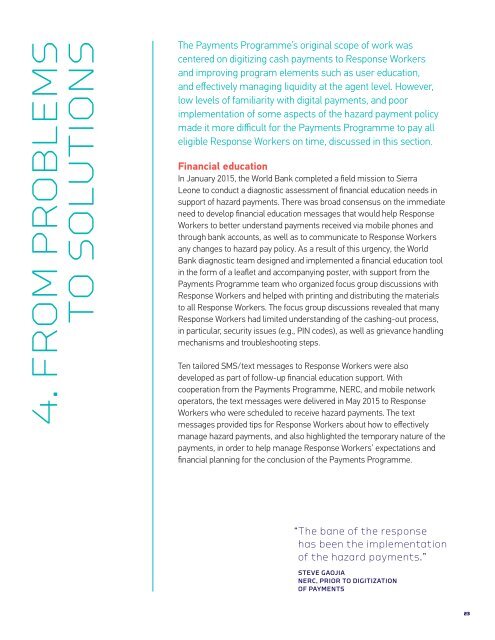LEONE
1U6Dtu2
1U6Dtu2
You also want an ePaper? Increase the reach of your titles
YUMPU automatically turns print PDFs into web optimized ePapers that Google loves.
4. FROM PROBLEMS<br />
TO SOLUTIONS<br />
The Payments Programme’s original scope of work was<br />
centered on digitizing cash payments to Response Workers<br />
and improving program elements such as user education,<br />
and effectively managing liquidity at the agent level. However,<br />
low levels of familiarity with digital payments, and poor<br />
implementation of some aspects of the hazard payment policy<br />
made it more difficult for the Payments Programme to pay all<br />
eligible Response Workers on time, discussed in this section.<br />
Financial education<br />
In January 2015, the World Bank completed a field mission to Sierra<br />
Leone to conduct a diagnostic assessment of financial education needs in<br />
support of hazard payments. There was broad consensus on the immediate<br />
need to develop financial education messages that would help Response<br />
Workers to better understand payments received via mobile phones and<br />
through bank accounts, as well as to communicate to Response Workers<br />
any changes to hazard pay policy. As a result of this urgency, the World<br />
Bank diagnostic team designed and implemented a financial education tool<br />
in the form of a leaflet and accompanying poster, with support from the<br />
Payments Programme team who organized focus group discussions with<br />
Response Workers and helped with printing and distributing the materials<br />
to all Response Workers. The focus group discussions revealed that many<br />
Response Workers had limited understanding of the cashing-out process,<br />
in particular, security issues (e.g., PIN codes), as well as grievance handling<br />
mechanisms and troubleshooting steps.<br />
Ten tailored SMS/text messages to Response Workers were also<br />
developed as part of follow-up financial education support. With<br />
cooperation from the Payments Programme, NERC, and mobile network<br />
operators, the text messages were delivered in May 2015 to Response<br />
Workers who were scheduled to receive hazard payments. The text<br />
messages provided tips for Response Workers about how to effectively<br />
manage hazard payments, and also highlighted the temporary nature of the<br />
payments, in order to help manage Response Workers’ expectations and<br />
financial planning for the conclusion of the Payments Programme.<br />
“The bane of the response<br />
has been the implementation<br />
of the hazard payments.”<br />
STEVE GAOJIA<br />
NERC, PRIOR TO DIGITIZATION<br />
OF PAYMENTS<br />
23



